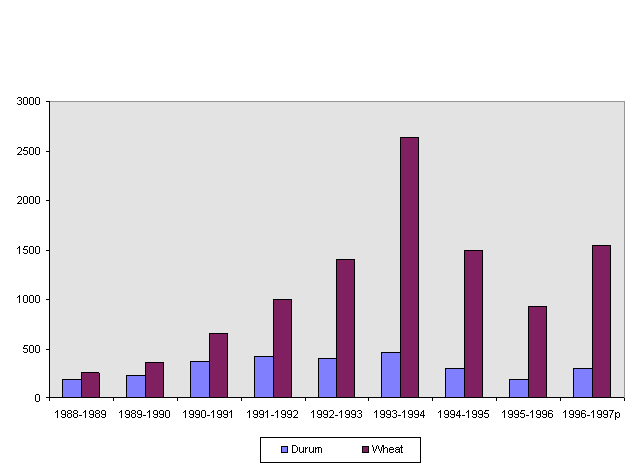PRB 98-2E
CANADA-U.S. GRAIN TRADE RELATIONS
Prepared by:
Sonya Dakers, Science and Technology Division
Jean-Denis Fréchette, Economics Division
September 1998
When
two countries trade nearly a billion dollars worth of goods and services of all sorts
between themselves everyday, frictions are bound to arise from time to time. The agri-food
business is no exception to this rule, and the grains sector in particular has seen more
than its share of disputes for some years. Since a picture is worth a thousand words, we
present the following graph, which shows clearly why the Americans have been attacking on
this front.

Especially
high exports of Canadian wheat in 1993-94 exacerbated these attacks to the point where the
two countries signed a trade agreement in August 1994 placing limits on Canadian exports.
That one-year agreement allowed Canada to export a total of 300,000 tonnes of durum wheat
at a minimum tariff of U.S.$3.08 per tonne, which was the then prevailing NAFTA tariff. It
was also agreed to reduce this tariff to U.S.$2.31 in 1995. For exports within a band of
300,000 to 450,000 tonnes, the agreement called for a tariff of U.S.$23, and all exports
in excess of that band were to be subject to a prohibitive tariff of U.S.$50 per tonne.
That agreement also provided that, for all other categories of wheat, the minimum NAFTA
would apply for exports up to 1.05 million tonnes: beyond that threshold, a
prohibitive tariff of U.S.$50 per tonne would come into effect.
In 1996-97, when the Americans
found that the pace of Canadian wheat exports was following essentially the same trend as
in 1993-94, they again demanded that limits be imposed. This reaction would seem to
indicate that, even though the 1994 agreement was supposed to apply for only one year, it
has set a precedent that the Americans are taking as a point of reference. In the end, no
measures were taken, because the rate of exports declined towards the end of the 1996-97
crop year, leaving total wheat exports for that year as a whole at about 1.6 million
tonnes.
In July 1995,
in the wake of the trade agreement, the then Minister of Agriculture and Agri-Food Canada,
Mr. Ralph Goodale, set up a committee to conduct an exhaustive examination of issues
relating to the marketing of Western grains. In its report, published a year later, the
Western Grains Marketing Committee issued a series of recommendations that were on the
whole well received by the grain industry. (Agriculture Canada) Although that
report was drawn upon heavily in preparing Bill C-72, An Act to amend the Canadian Wheat
Board Act, that bill received a much cooler reception than the Committee’s report
itself, suggesting that the drafters of the bill had not gone as far in restructuring the
CWB and the marketing of wheat in general as the industry would have liked. The bill died
on the order paper when the thirty-fifth Parliament was dissolved.
Its successor,
Bill C-4, received Royal Assent on 11 June 1998. Though, under the bill, the
"new" CWB would no longer be a Crown corporation, it is safe to assume that this
new status will not be in itself enough to stop American criticism.
The U.S. government’s
grain export program (Export Enhancement Program) often leads to domestic shortages;
Canadian wheat can then be imported without harming the American market. Even though the
imported Canadian wheat is only responding to normal demand, some Americans consider it to
be the result of a Canadian plot to displace American wheat. Thus, American politicians
representing the border States regularly denounce Canadian imports of wheat and, as a
result, commercial relations between the two countries are strained.
|
